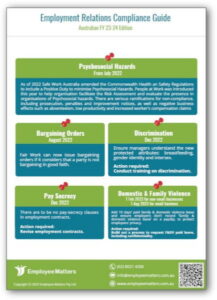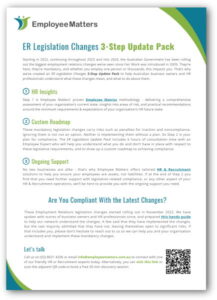Where does Australia rank in terms of Paid Parental Leave?
It is fair to say that when it comes to Paid Parental Leave (PPL), Australia was late to the party. Before the first scheme was introduced in 2011, Australia was one of only 2 OECD countries who did not have such a scheme. Even now, many would suggest that our paid parental leave scheme lags behind many similar economies [1] (with the notable exception of the USA).
However, things are changing, albeit not as fast as many would like. The schedule to commence lifting the length of the government scheme is underway [2]. From 18 weeks paid leave prior to 1 July 2023, the length of PPL is increasing by 10 days (2 weeks) per year until it reaches 26 weeks from 1 July 2026. There is also much greater flexibility being introduced around who can take parental leave and who will be paid for it.
There is a ‘But’ however; the level of PPL in Australia is tied to the National Minimum Wage rather than the employee’s actual wage. Many of our OECD colleagues have at least some elements of PPL that are tied to actual wages or at least average wages rather than minimum wage.
So with this in mind, there are moves for employers to ‘top up’ the government PPL scheme with their own payments.
Are Employees being Offered Employer-Paid Parental Leave?
The Workplace Gender Equality Agency (WGEA) in its annual scorecard reports 63% of employers in their survey are offering some sort of employer-paid parental leave in addition to the government PPL scheme (up 1% from the previous year). Remember however, the WGEA figures are based on their survey, which is only compulsory for businesses with 100+ employees. Nevertheless there is a move to offer such schemes, so the obvious question is why?
Why Offer Employer-Paid Parental Leave?
In our talent-scarce employment environment, everything that encourages talented people to remain in the workforce with their current employer is an obvious win. Your Employee Value Proposition (EVP) is key not only to attracting the best talent in the market but also retaining your key talent; anything that does this must be worth considering.
Referring again to the OECD comparisons, we can see the difference a good scheme can make. Comparing Sweden and USA (which have similar birth rates), the percentage of women working in those countries represents a stark difference. Sweden with its generous PPL schemes has a female employment rate of 82%, whereas the USA only has a 69% female employment rate.
Nor is this all about mothers. The flexibility being introduced for taking government PPL which does away with ‘Dad and Partner’ pay in favour of a shared pool of PPL will hopefully see many more men taking time as a primary carer to support and bond with their children, rather than the current level of only 14%.
What should You Offer in Terms of Employer-Paid Parental Leave?
So you have seen the benefits of offering employer-paid parental leave - what next?
Here are some things to consider:
- Length of pay?
- Should this be the same at the government scheme and if so:
- Will you increase it in line with the government scheme?
- Will you introduce your scheme now at the 2026 limit of 26 weeks?
- Should this be the same at the government scheme and if so:
- Amount of pay?
- Will you pay the employee their normal pay in addition to the government scheme?
- Will you pay the same as the government rate (i.e. the national minimum wage)?
- Will you top up the difference between the government PPL and normal pay for the employee?
- Pay options
- Are there options for how employer-paid parental leave will be taken? e.g.
- Agreed period at your rate for employer-paid PPL?
- Twice the period at half the rate?
- Are there options for how employer-paid parental leave will be taken? e.g.
At Employee Matters, we have helped clients design and implement custom employer-paid parental leave programs across a variety of the above options..
Here are just four example employer PPL offerings:
- Option of three months at full pay or 6 months at half pay
- Four weeks at full pay
- Six weeks pay at same rate as the government scheme
- 12 weeks in addition to the government scheme
If you need help and guidance designing and introducing an employer paid parental leave scheme that’s the right fit for your business, please get in touch and speak with an experienced member of the Employee Matters team:
Phone: 02 8021 4206
Email: info@employeematters.com.au
... or drop us a line using the form below:
Need HR/Recruitment Support?
Call (02) 8021 4206 or email info@employeematters.com.au to discuss your HR, Recruitment or ER Legislation challenges with an experienced member of the Employee Matters team.
Alternatively, you can book a free call by completing the adjacent form:
Sources (retrieved 2/5/2024):
[1] Australian Government factsheet: "International examples of paid parental leave schemes"
[2] Australian Government / Services Australia page: "Changes if you get family payments"
Related Content
Employee Relations Legislation Changes Hub
There is a significant amount of mandatory Employment Relations legislative change that impacts you and every other business in Australia now. Our resource hub is designed to help you understand these wide-ranging changes.

3-STEP UPDATE PACK
Take the first step to be compliant. Our 3-Step Update Pack helps Australian business owners and HR professionals understand what these new ER legislation changes mean and what to do about them.
Step 1 - HR Insights
Step 2 - Custom Roadmap
Step 3 - Ongoing Support

